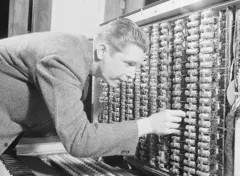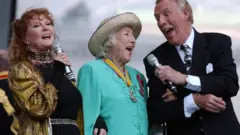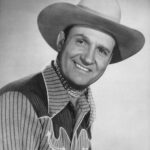Dame Vera Lynn’s “We’ll Meet Again” is more than just a song; it’s a cultural touchstone. This timeless ballad, forever linked to the indomitable spirit of wartime Britain, became Dame Vera’s signature tune and resonated deeply across generations. From its unexpected synth origins to its poignant use in films like Dr. Strangelove and TV series such as Stranger Things, the song’s journey is as captivating as its melody. Let’s explore the remarkable history of “We’ll Meet Again” and how it became an enduring symbol of hope and resilience.
Dame Vera recorded “We’ll Meet Again” multiple times, with the 1943 film version being the most iconic.
“We’ll Meet Again,” a song synonymous with Dame Vera Lynn, holds a unique place in musical history. Beyond being her signature piece, it boasts the surprising distinction of being among the earliest singles to feature a synthesizer. Despite initial criticisms of being overly sentimental for troops, the song’s powerful message of hope transcended skepticism, embedding itself in popular culture, from Stanley Kubrick’s Dr. Strangelove to the contemporary hit Stranger Things.
At a time of national uncertainty and conflict, no song encapsulated the spirit of Britain quite like “We’ll Meet Again.” Vera Lynn’s 1939 recording became an anthem of resilience for a nation at war, offering solace to those separated from loved ones. The simple yet profound lyrics, “We’ll meet again, don’t know where, don’t know when / But I know we’ll meet again, some sunny day,” spoke directly to the hearts of a generation facing unprecedented hardship.
The song’s impact has echoed through the years. Quoted by Queen Elizabeth II in times of national crisis and covered by music icons like Johnny Cash, “We’ll Meet Again” re-entered the UK charts in recent times, proving its enduring relevance as a message of hope during the coronavirus pandemic.
Dame Vera herself recognized the song’s universal appeal. In her 1975 autobiography, Vocal Refrain, she described it as a “greetings card song,” perfectly capturing “a very basic human message” that people often find difficult to express directly.
The Birth of a Wartime Classic
In 1939, as the shadow of war loomed over Europe, a young Vera Lynn, just 22 years old, embarked on a search for new material in London’s Tin Pan Alley, Denmark Street. During this “phoney war” period, before the full intensity of conflict erupted, she encountered Hughie Charles, a songwriter with a keen sense for the public mood.
Charles, who had traded a promising cricket career for music, recognized Lynn’s talent and presented her with two songs he had co-written with Ross Parker. These songs, “There’ll Always Be An England,” a stirringly patriotic piece, and “We’ll Meet Again,” a more reflective and hopeful ballad, were conceived to resonate with a nation on the brink of war.
Lynn debuted “We’ll Meet Again” in the summer of 1939 with Bert Ambrose and his orchestra. Reflecting on early reviews, she noted in a 1995 interview with The Guardian that the song immediately resonated with audiences and critics alike. Its message of hope and reunion made it a perfect closing number, and it quickly became a staple of her performances.
A Synth-Pop Pioneer Emerges
The melody of “We’ll Meet Again” subtly draws inspiration from Anton Rubinstein’s classical piece, “Melody in F.” However, it was Vera Lynn’s deeply personal and emotionally resonant delivery that truly captivated listeners. Her distinctive, low vocal tone perfectly captured the prevailing sentiment of the era.
 A polyphonic synthesizer Hansel Mieth/Time Life
A polyphonic synthesizer Hansel Mieth/Time Life
A polyphonic synthesizer, the Hammond Novachord, made its public debut at the 1939 New York World’s Fair.
Lynn’s initial recording of “We’ll Meet Again” in 1939 was groundbreaking for its time. Accompanied by Arthur Young on the Hammond Novachord, the world’s first commercial polyphonic synthesizer, the song became a pioneering example of early synth use in popular music. This “instrument that reproduces the tone of a dozen instruments,” unveiled just months prior at the New York World’s Fair, marked Lynn’s recording as potentially the very first pop single to feature a synthesizer. While this initial version was significant, it was a later recording, enriched with a full orchestral arrangement, that would achieve iconic status.
Sincerely Yours: Broadcasting Hope to the Nation
As Vera Lynn’s popularity grew, she became a central figure on forces’ radio with her program Sincerely Yours. Every Sunday evening, over 20% of the British public tuned in to hear Dame Vera sing songs of encouragement and read heartfelt letters between loved ones separated by the war.
“Although broadcast from a studio, I always envisioned myself singing and speaking from home,” Dame Vera recalled. She aimed to create an intimate atmosphere, addressing not a vast audience but “scattered individuals – an intimate conversation, but to a couple of million people.”
Each Sincerely Yours episode concluded with “We’ll Meet Again.” Her reassuring lyrics, “Keep smiling through / Just like you always do,” became a weekly message of hope. However, not everyone embraced the sentimentality. Following a series of military setbacks, a vocal minority criticized “radio crooners” and “sloppy sentimental rubbish,” arguing it negatively impacted troop morale. Critics demanded “something more virile” on the airwaves.
The ‘Anti-Slush’ Campaign and Enduring Popularity
Responding to these criticisms, the BBC established the Dance Music Policy Committee, known as the “anti-slush” committee, to regulate broadcast music. The committee aimed to eliminate “sickly sentimentality” deemed “nauseating and not at all in keeping with what we feel to be the need of the public.” Bing Crosby’s “I’ll Be Home For Christmas” and The Mills Brothers’ “Paper Doll” were among the songs banned under this policy.
Vera Lynn was honored as a Dame Commander of the Order of the British Empire in 1975, later becoming Dame Grand Cross in 2016.
Dame Vera staunchly defended her program and the emotional connection it fostered. In a Sunday Dispatch column, she asserted that servicemen and their families deeply valued the sentiment of Sincerely Yours. She cited the immense volume of letters from soldiers – 1,000 per week, totaling 18,000 and continuing – as evidence of the show’s importance.
Dame Vera believed “We’ll Meet Again” served a vital purpose: “reminding the boys of what they were really fighting for, the precious, personal things rather than the ideologies and theories.”
An eloquent defense of Dame Vera’s impact came from a listener who wrote to the Radio Times, praising her ability to imbue even “sentimental twaddle” with genuine emotion and belief. He lauded her for making each song feel newly discovered and generously shared, captivating her audience with their “peculiar delights.”
Despite this public support, the BBC briefly cancelled Sincerely Yours. However, Dame Vera’s popularity remained undiminished.
In 1943, she starred in the film We’ll Meet Again, a fictionalized account of her life, where a young dancer uses her singing talent to entertain British troops. The film’s finale featured a re-recorded version of the title song, which became the definitive and most beloved rendition. Sincerely Yours was subsequently reinstated, and Dame Vera continued to tour globally, performing for troops.
 Dame Vera Lynn with Petula Clark and Bruce Forsyth PA Media
Dame Vera Lynn with Petula Clark and Bruce Forsyth PA Media
Dame Vera Lynn with Petula Clark and Bruce Forsyth at the 60th anniversary of the end of World War Two in 2005.
An Anthem for Generations
While “We’ll Meet Again”‘s bittersweet message resonated profoundly during wartime, its appeal extended far beyond 1945. The song transcended its wartime origins to become a universal anthem of hope and resilience in the face of adversity.
Covered by musical giants like Frank Sinatra, Peggy Lee, Rod Stewart, and Sammy Davis Jr., “We’ll Meet Again” entered the broader cultural landscape. Pink Floyd referenced it in their song “Vera,” and Stanley Kubrick masterfully employed it in the closing scenes of Dr. Strangelove, adding a layer of poignant irony to the film’s apocalyptic satire.
During the Cold War, the BBC’s Wartime Broadcasting Service selected “We’ll Meet Again” as one of the songs to be broadcast to comfort survivors of a nuclear attack. Its message of hope in the face of unimaginable devastation remained powerfully relevant.
In more recent times, “We’ll Meet Again” has appeared in contemporary media, from Stranger Things to The Simpsons, Hellboy, and Trainspotting 2. It even provides the atmospheric backdrop for the Tower of Terror ride at Disney theme parks.
The song’s enduring message of resilience experienced a resurgence during the 2020 coronavirus pandemic. Queen Elizabeth II, in a televised address to the nation, echoed the song’s sentiment, declaring, “We will be with our friends again. We will be with our families again. We will meet again.” This royal endorsement propelled “We’ll Meet Again” back into the UK charts, 81 years after its initial release, demonstrating its timeless appeal.
Dame Vera Lynn herself expressed enduring affection for the song. “I never tired of singing it,” she wrote. She was deeply moved by the song’s lasting legacy, noting, “I’m told that schoolchildren today still learn the words to We’ll Meet Again. That thrills me.” “We’ll Meet Again” is more than just a song; it’s a testament to the human spirit’s ability to find hope in the darkest of times, a legacy Dame Vera Lynn indelibly imprinted on the world.

